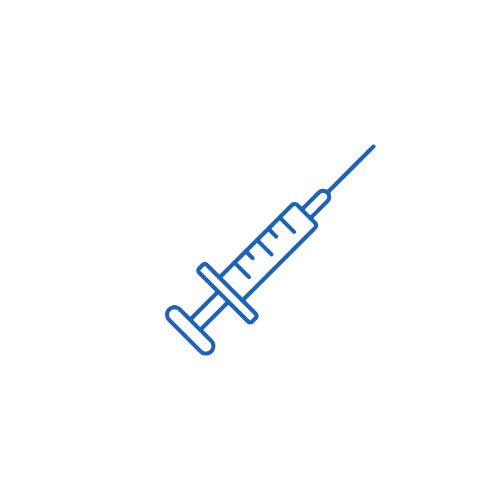Measles and Rubella
Medicines List
All MedicineIndications
Approved Indications:
- Routine immunization against measles and rubella in children, adolescents, and adults without documented immunity.
- Catch-up vaccination for individuals who missed scheduled childhood doses.
- Outbreak control to limit transmission of measles and rubella in affected communities.
Target Populations:
- Children: As part of the routine childhood immunization schedule (typically at 9–12 months and again at 15–18 months or school entry).
- Women of childbearing age: To prevent congenital rubella syndrome (CRS), especially in non-pregnant, seronegative individuals.
- Healthcare workers and travelers: Without documented immunity.
Off-label / Expanded Use:
- Post-exposure prophylaxis (PEP): Within 72 hours of exposure to measles in susceptible individuals.
- Supplementary Immunization Activities (SIAs): Mass campaigns targeting children to close immunity gaps.
Dosage & Administration
Route: Subcutaneous injection, preferably in the upper arm (deltoid region) or outer thigh (anterolateral thigh in young children).
Routine Schedule:
- First dose: At 9–12 months of age (varies by country immunization program).
- Second dose: At 15–18 months or at school entry (ages 4–6 years).
Catch-up Schedule:
- Individuals aged ≥1 year without vaccination history: Two doses, at least 4 weeks apart.
Adults:
- Non-immune adults: Two doses, 4 weeks apart.
Pregnancy:
- Contraindicated. Delay until postpartum period.
Immunocompromised Patients:
- Generally contraindicated, especially in severe immunodeficiency. Live attenuated vaccines can pose risks.
Mechanism of Action (MOA)
The Measles and Rubella (MR) vaccine contains live attenuated viruses of measles (Edmonston-Zagreb or Schwarz strain) and rubella (RA27/3 strain). Following subcutaneous injection, these attenuated viruses replicate locally and stimulate the host’s immune system, generating a robust humoral (IgG) and cellular immune response. This leads to long-lasting immunity by inducing memory B and T cells that recognize and rapidly neutralize wild-type viruses upon future exposure. Protective antibodies against measles and rubella generally develop within 10–14 days after vaccination.
Pharmacokinetics
As a live attenuated vaccine, traditional pharmacokinetics (ADME) are not applicable. However:
- Onset of Immunity: Protective antibodies typically appear within 10–14 days post-vaccination.
- Duration of Immunity: Often lifelong after two doses; booster not typically required.
- Distribution: Local replication at injection site, followed by immune response activation in lymphoid tissue.
Pregnancy Category & Lactation
- Pregnancy:
Contraindicated. Live rubella virus may pose a theoretical risk to the fetus, though no confirmed congenital rubella cases have resulted from vaccination. Women of childbearing age should avoid pregnancy for 1 month after vaccination. - Lactation:
Generally considered safe. Rubella vaccine virus may be excreted in breast milk but has not been associated with adverse effects in breastfeeding infants.
Therapeutic Class
- Primary Class: Vaccine
- Subclass: Live Attenuated Viral Vaccine (Measles + Rubella)
Contraindications
- Known hypersensitivity to neomycin, gelatin, or any vaccine component
- History of severe allergic reaction (e.g., anaphylaxis) to prior measles or rubella vaccine
- Pregnancy
- Severe immunosuppression (e.g., HIV with low CD4, cancer chemotherapy, organ transplantation)
- Acute febrile illness (postpone vaccination)
Warnings & Precautions
- Immunocompromised Individuals: May develop vaccine-related disease; use is contraindicated in severe cases.
- Thrombocytopenia: Use with caution in individuals with history of vaccine-related thrombocytopenia or ITP.
- Seizure History: Post-vaccine fever may provoke febrile seizures in predisposed children.
- Close contacts of pregnant or immunocompromised persons: Generally safe, but minor risk of viral shedding.
- Anaphylaxis Management: Facilities for treating severe allergic reactions should be available at vaccination site.
Side Effects
Common (Mild to Moderate):
- Fever (5–15%)
- Rash (1–5%)
- Pain, redness, or swelling at injection site
- Irritability or fatigue
Less Common / Serious:
- Febrile seizures (especially after first dose, 1 in 3,000–4,000 cases)
- Transient lymphadenopathy
- Thrombocytopenia or ITP (rare)
- Allergic reactions (rash, urticaria)
Rare Serious Reactions:
- Anaphylaxis
- Aseptic meningitis (extremely rare)
- Encephalitis (estimated 1 in 1,000,000)
Onset Timing:
- Fever and rash typically occur 7–12 days after vaccination
- Allergic reactions usually occur within 1–2 days
Drug Interactions
- Immunoglobulin (IG) Therapy: Avoid MR vaccination within 3–11 months after receiving immune globulin products, as these may interfere with immune response.
- Other Live Vaccines: Can be given simultaneously, or must be spaced ≥28 days apart if not given on the same day.
- Immunosuppressive drugs (e.g., corticosteroids, chemotherapy): May impair vaccine efficacy—delay vaccination until recovery.
Recent Updates or Guidelines
- WHO/UNICEF Immunization Schedule Update (2023): Reaffirmed the two-dose MR schedule as part of global measles and rubella elimination strategy.
- GAVI and WHO SIAs (2024): Expanded measles-rubella catch-up campaigns across high-risk populations in Africa and Southeast Asia.
- Surveillance Emphasis: Countries urged to integrate measles-rubella serosurveillance to guide supplemental immunization activities (SIAs).
Storage Conditions
- Temperature: Store refrigerated at 2°C to 8°C (36°F to 46°F).
- Light Sensitivity: Protect from light. Store in original carton.
- Do Not Freeze: Freezing may damage the live virus.
- Reconstitution:
- Use only the diluent provided.
- Reconstitute just before use.
- Use within 6 hours of reconstitution.
- Discard unused vaccine after 6 hours or at the end of the immunization session.
